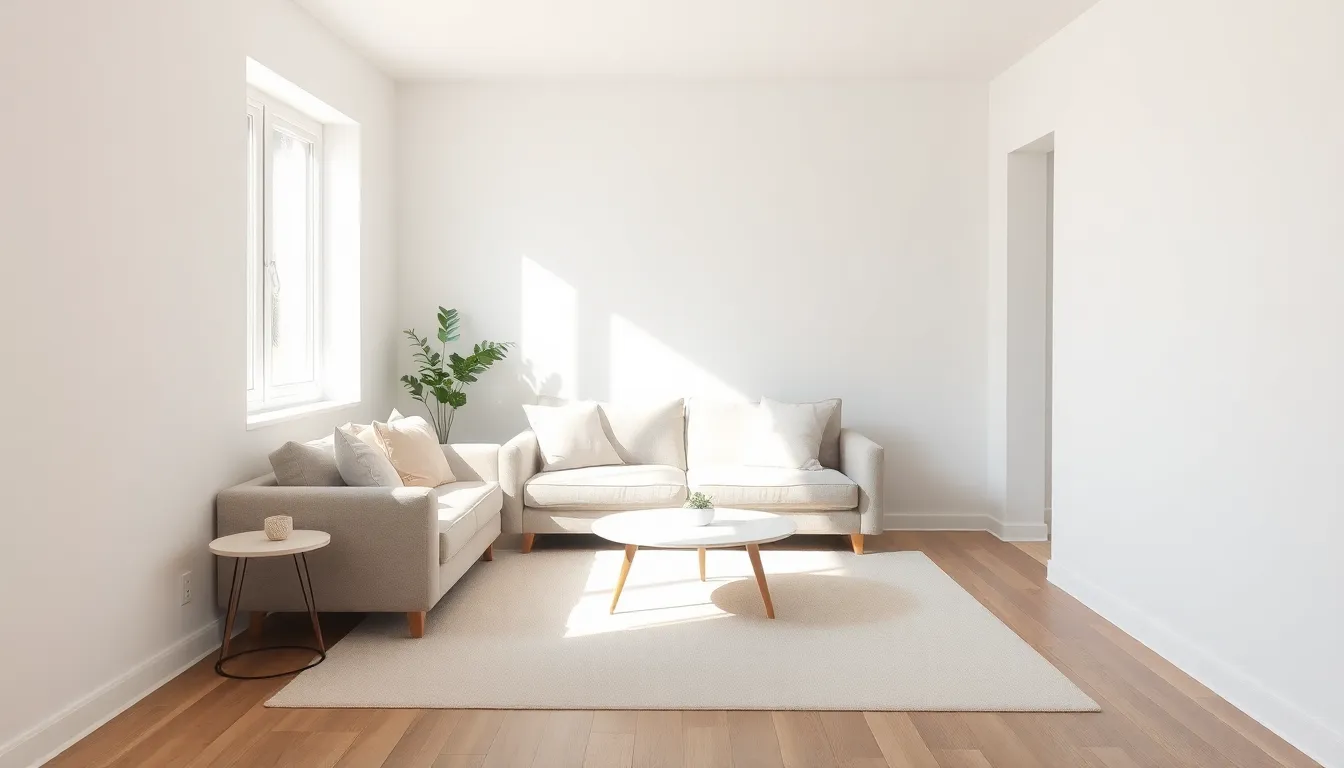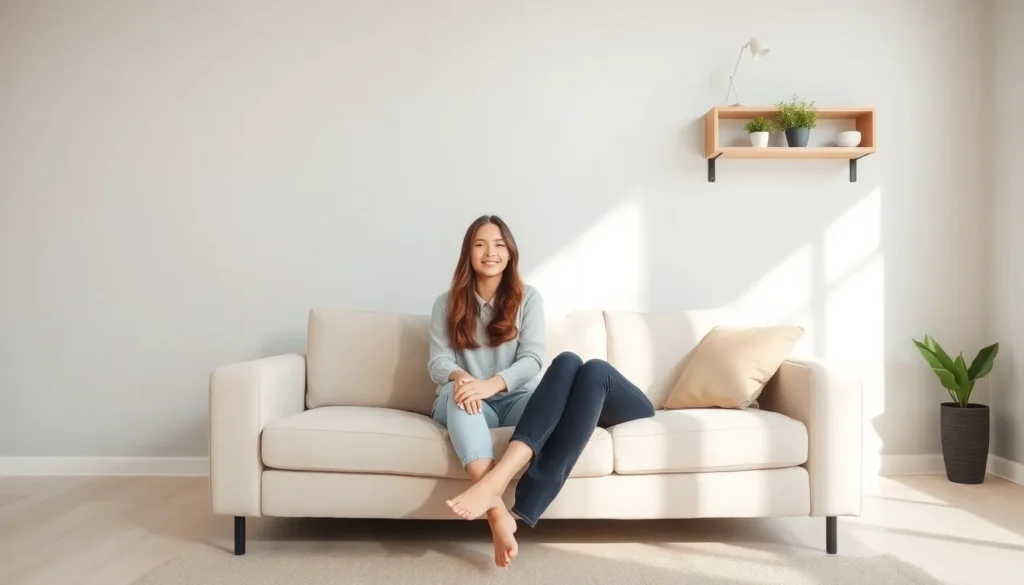Table of Contents
ToggleIn a world where bigger often seems better, the minimalist small living room proves that less really can be more. Imagine a space so perfectly curated that every item serves a purpose and looks fabulous doing it. It’s like your living room went on a diet and came back looking fabulous, with more room for activities and less clutter to trip over.
Understanding Minimalist Design
Minimalist design emphasizes simplicity and functionality. A space reflects tranquility when it contains only essential elements.
Key Principles of Minimalism
Simplicity defines minimalist design. Minimalist spaces prioritize fewer, well-chosen items that serve a clear purpose. Functionality focuses on making each piece useful, encouraging practicality over excess. Neutral color palettes enhance cohesion and calmness, creating inviting atmospheres. Clean lines contribute to a sense of organization, making small living rooms feel more spacious.
Benefits of Minimalist Small Living Rooms
Space maximization becomes a significant advantage. Minimalist living rooms offer more room for movement, preventing clutter-induced stress. Visual clarity enhances focus, promoting relaxation and peace. Cost-effectiveness arises from investing in fewer, high-quality furnishings that last longer. Sustainability gains importance when choosing durable materials over disposable items, benefiting both the environment and personal finances.
Designing a Minimalist Small Living Room

Creating a minimalist small living room requires thoughtful design choices. Each element contributes to a functional and inviting space.
Choosing the Right Color Palette
Neutral tones establish a serene backdrop in minimalist design. Shades like white, beige, and soft gray promote visual openness. Consider adding accents of pastel hues for a touch of warmth without overwhelming the senses. Cohesive colors unify the space, enhancing its overall tranquility. Opt for matte finishes to minimize distractions and maintain simplicity.
Furniture Selection and Arrangement
Selecting furniture demands careful consideration of function and form. She prioritizes pieces that offer practicality, such as multi-functional sofas or storage ottomans. Arranging furniture should foster flow and accessibility, allowing for easy movement. Create designated areas for relaxation and entertainment to maximize utility. Lean towards fewer, quality items rather than cluttering the space with excess. Embrace clean lines and geometric shapes, which align with minimalist ideals and evoke a sense of organization.
Decor Ideas for Minimalist Small Living Rooms
Minimalist small living rooms can benefit significantly from well-thought-out decor ideas. Simple, functional pieces enhance the aesthetic while maintaining the room’s spacious feel.
Incorporating Functional Decor
Functional decor transforms small living rooms into practical retreats. Choose wall-mounted shelves that display items without consuming floor space. Select decorative items that serve dual purposes, such as a stylish basket for storage or a multifunctional coffee table. Artwork can incorporate hidden storage while contributing visual interest. Opt for plants to bring life into the room while improving air quality. Natural materials, such as wood or stone, add warmth without overwhelming the senses.
Utilizing Storage Solutions
Effective storage solutions maximize space in a minimalist setting. Invest in furniture with built-in storage, such as ottomans or benches that open to reveal compartments. Floating shelves help keep surfaces clear while showcasing curated decor. Utilize hidden storage in plain sight, placing items in decorative boxes or under couches. Incorporating vertical storage frees up floor area, creating a clean, open environment. Decluttering regularly ensures that only essential items occupy the space, reinforcing the minimalist concept.
Maintaining a Minimalist Small Living Room
Maintaining a minimalist small living room involves consistent efforts in organization and decluttering to keep the space serene and functional.
Regular Decluttering Habits
Regular decluttering habits play a crucial role in sustaining minimalist aesthetics. Schedule time each week to evaluate items in the living room. Assess furniture and decor, ensuring each piece serves a distinct purpose. Discard anything that no longer contributes to the environment. Utilize designated bins for sorting items to facilitate donation or recycling. Implementing a “one in, one out” rule can further limit accumulation. This principle promotes mindfulness in purchasing new items. Through these practices, a small living room remains open and inviting, enhancing overall tranquility.
Tips for Keeping the Space Organized
Tips for keeping the space organized enhance the minimalist approach. Utilize multi-functional furniture, such as ottomans with storage, to minimize clutter. Keep surfaces clear by assessing what truly belongs there, reserving space only for essential items. Use baskets or decorative boxes to organize smaller objects, ensuring they aren’t visible. Position furniture to allow for easy movement, promoting a sense of spaciousness. Labeling storage containers adds clarity to organization efforts. Each of these strategies contributes to maintaining a clean, minimalist environment that feels larger and more relaxing.
Embracing a minimalist approach in a small living room can transform the space into a serene and functional haven. By prioritizing essential items and maintaining an organized environment, individuals can enjoy a visually appealing area that promotes relaxation. Thoughtful design choices like neutral color palettes and multi-functional furniture not only enhance aesthetics but also maximize the available space.
Regular decluttering and effective storage solutions play a crucial role in sustaining the minimalist lifestyle. With these strategies in place, a small living room can remain a tranquil retreat, reflecting the beauty of simplicity while meeting the demands of everyday life. Ultimately, minimalism offers a pathway to a more intentional and fulfilling living experience.








